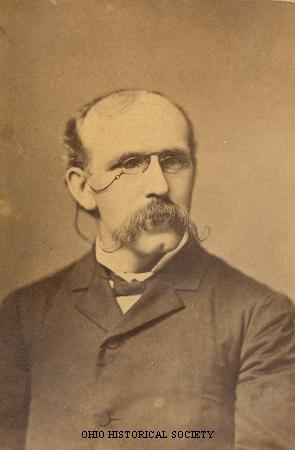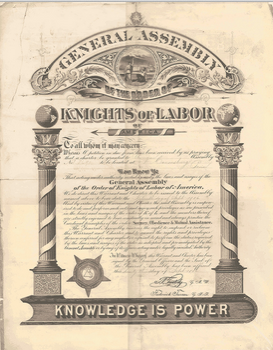Encyclopedia Dubuque
"Encyclopedia Dubuque is the online authority for all things Dubuque, written by the people who know the city best.”
Marshall Cohen—researcher and producer, CNN
Affiliated with the Local History Network of the State Historical Society of Iowa, and the Iowa Museum Association.
KNIGHTS OF LABOR: Difference between revisions
No edit summary |
No edit summary |
||
| Line 3: | Line 3: | ||
[[File:powderly.jpg|150px|thumb|left|Terence V. Powderly]]THE NOBLE AND HOLY ORDER OF THE KNIGHTS OF LABOR. The Knights of Labor, a first important national labor organization in the United States was established in 1869. (1) It served as an umbrella organization for other unions that joined it. Founded by Uriah Stevens, the Knights of Labor was originally a secret organization, but Terence Powderly, elected as grand master workman, ended the group's secrecy and removed the word "noble" from its title after assuming control of the organization in 1879. (2) Membership grew quickly, reaching approximately 700,000 members by 1886. (3) | [[File:powderly.jpg|150px|thumb|left|Terence V. Powderly]]THE NOBLE AND HOLY ORDER OF THE KNIGHTS OF LABOR. The Knights of Labor, a first important national labor organization in the United States was established in 1869. (1) It served as an umbrella organization for other unions that joined it. Founded by Uriah Stevens, the Knights of Labor was originally a secret organization, but Terence Powderly, elected as grand master workman, ended the group's secrecy and removed the word "noble" from its title after assuming control of the organization in 1879. (2) Membership grew quickly, reaching approximately 700,000 members by 1886. (3) | ||
[[File:koc1.png|150px|thumb|left|Terence V. Powderly]]The Knights of Labor attempted to unite all "producers," anyone who produced a physical product during a workday. While welcoming factory workers and business owners, the group rejected "social parasites"—people who did not engage in physical labor, such as bankers, lawyers, liquor dealers, stock brokers and professional gamblers. (4) The organization even allowed women and [[AFRICAN AMERICANS]] to join. The producers sought an eight-hour workday, an end to child labor, better wages, and improved working conditions. Under Powderly's leadership, the organization also provided support for the temperance movement. (5) At its peak, membership in the organization exceeded 700,000. (6) | [[File:koc1.png|150px|thumb|left|Terence V. Powderly]] | ||
The Knights of Labor attempted to unite all "producers," anyone who produced a physical product during a workday. While welcoming factory workers and business owners, the group rejected "social parasites"—people who did not engage in physical labor, such as bankers, lawyers, liquor dealers, stock brokers and professional gamblers. (4) The organization even allowed women and [[AFRICAN AMERICANS]] to join. The producers sought an eight-hour workday, an end to child labor, better wages, and improved working conditions. Under Powderly's leadership, the organization also provided support for the temperance movement. (5) At its peak, membership in the organization exceeded 700,000. (6) | |||
[[File:koc2.png|150px|thumb|left|Terence V. Powderly]]The Knights of Labor used boycotts and peaceful negotiations. Powderly generally opposed strikes, believing that they led to bloodshed and increased tensions. Other Knights of Labor leaders preferred utilizing strikes. Following the Haymarket Square Riot in Chicago, Illinois, in 1886, the backlash against unionism and dissatisfaction of many members led to the establishment of the American Federation of Labor (AFL) in December 1886. The American Federation of Labor (AFL) focused on winning economic benefits for its members through collective bargaining. As a federation, it represented several national autonomous craft unions. The Knights, on the other hand, represented both craft and unskilled workers in a single national union. (7) The Knights of Labor declined as an effective organization and Powderly resigned as the organization's head in 1893. (8) In addition to raising issues that were later won for organized labor, one of their most lasting contributions of the Knights of Labor was Labor Day, an event they sponsored. (9) | [[File:koc2.png|150px|thumb|left|Terence V. Powderly]] | ||
The Knights of Labor used boycotts and peaceful negotiations. Powderly generally opposed strikes, believing that they led to bloodshed and increased tensions. Other Knights of Labor leaders preferred utilizing strikes. Following the Haymarket Square Riot in Chicago, Illinois, in 1886, the backlash against unionism and dissatisfaction of many members led to the establishment of the American Federation of Labor (AFL) in December 1886. The American Federation of Labor (AFL) focused on winning economic benefits for its members through collective bargaining. As a federation, it represented several national autonomous craft unions. The Knights, on the other hand, represented both craft and unskilled workers in a single national union. (7) The Knights of Labor declined as an effective organization and Powderly resigned as the organization's head in 1893. (8) In addition to raising issues that were later won for organized labor, one of their most lasting contributions of the Knights of Labor was Labor Day, an event they sponsored. (9) | |||
Dubuque was the largest manufacturing city in Iowa during the 1880s. A profile of the city's working-class population in the mid-1880s indicates that a typical worker was employed ten hours daily with wage rates determined by age, job, and sex. Women and children, involved in low-paying factory, retail and service occupations, earned the least. Wages earned by women average one-third to one-half those of men. Boys received less than women and girls made less than boys. Common male occupations included blacksmiths, carpenters, machinists, railway workers, and teamsters. Unskilled male workers earned from $1.00 to $1.50 daily as compared to bricklayers who earned from $3.75 to $4.00. Common laborers rented homes while between one-third and one-half of the tradesmen owned their own homes. (10) | Dubuque was the largest manufacturing city in Iowa during the 1880s. A profile of the city's working-class population in the mid-1880s indicates that a typical worker was employed ten hours daily with wage rates determined by age, job, and sex. Women and children, involved in low-paying factory, retail and service occupations, earned the least. Wages earned by women average one-third to one-half those of men. Boys received less than women and girls made less than boys. Common male occupations included blacksmiths, carpenters, machinists, railway workers, and teamsters. Unskilled male workers earned from $1.00 to $1.50 daily as compared to bricklayers who earned from $3.75 to $4.00. Common laborers rented homes while between one-third and one-half of the tradesmen owned their own homes. (10) | ||
Revision as of 04:47, 5 February 2015
This entry is being developed.
THE NOBLE AND HOLY ORDER OF THE KNIGHTS OF LABOR. The Knights of Labor, a first important national labor organization in the United States was established in 1869. (1) It served as an umbrella organization for other unions that joined it. Founded by Uriah Stevens, the Knights of Labor was originally a secret organization, but Terence Powderly, elected as grand master workman, ended the group's secrecy and removed the word "noble" from its title after assuming control of the organization in 1879. (2) Membership grew quickly, reaching approximately 700,000 members by 1886. (3)
The Knights of Labor attempted to unite all "producers," anyone who produced a physical product during a workday. While welcoming factory workers and business owners, the group rejected "social parasites"—people who did not engage in physical labor, such as bankers, lawyers, liquor dealers, stock brokers and professional gamblers. (4) The organization even allowed women and AFRICAN AMERICANS to join. The producers sought an eight-hour workday, an end to child labor, better wages, and improved working conditions. Under Powderly's leadership, the organization also provided support for the temperance movement. (5) At its peak, membership in the organization exceeded 700,000. (6)
The Knights of Labor used boycotts and peaceful negotiations. Powderly generally opposed strikes, believing that they led to bloodshed and increased tensions. Other Knights of Labor leaders preferred utilizing strikes. Following the Haymarket Square Riot in Chicago, Illinois, in 1886, the backlash against unionism and dissatisfaction of many members led to the establishment of the American Federation of Labor (AFL) in December 1886. The American Federation of Labor (AFL) focused on winning economic benefits for its members through collective bargaining. As a federation, it represented several national autonomous craft unions. The Knights, on the other hand, represented both craft and unskilled workers in a single national union. (7) The Knights of Labor declined as an effective organization and Powderly resigned as the organization's head in 1893. (8) In addition to raising issues that were later won for organized labor, one of their most lasting contributions of the Knights of Labor was Labor Day, an event they sponsored. (9)
Dubuque was the largest manufacturing city in Iowa during the 1880s. A profile of the city's working-class population in the mid-1880s indicates that a typical worker was employed ten hours daily with wage rates determined by age, job, and sex. Women and children, involved in low-paying factory, retail and service occupations, earned the least. Wages earned by women average one-third to one-half those of men. Boys received less than women and girls made less than boys. Common male occupations included blacksmiths, carpenters, machinists, railway workers, and teamsters. Unskilled male workers earned from $1.00 to $1.50 daily as compared to bricklayers who earned from $3.75 to $4.00. Common laborers rented homes while between one-third and one-half of the tradesmen owned their own homes. (10)
Prior to 1885, trade unions in Dubuque existed among printers, cigarmakers, locomotive firemen and engineers, tailors and bricklayers. Membership varied from twenty to forty. These groups protected their independence, decided work rules and wage scales, avoided politics, and held regular meetings. (11)
In 1885 when the Knights of Labor organized in Dubuque, they found a receptive audience. The Knights secret ritual and ceremony appealed to a distinctly dominate Catholic population of which many were members of the KNIGHTS OF PYTHIAS or the ANCIENT ORDER OF UNITED WORKMEN(A.O.U.W). In a society where workers were considered commodities, the Knights advocacy of "producers" was appreciated as well as its welcoming workers regardless of skill level, sex, race or nationality. (12) Led by John STAFFORD, Master Workman of Local Assembly No. 4192, organizing drives were held which resulted by December 1886, of six more locals joining the national organization. Dual union membership resulted with cigarmakers, printers and stationary engineers joined while keeping their trade union membership. (13)
Efforts were made without great success to organize African Americans who were personal servants, cooks and porters. While criticizing wage discrimination based on race, only about six blacks joined the organization with none holding leadership positions. (14)
Women became nearly 20% of the membership. While six of the seven Dubuque locals were male, Local Assembly No 5914 was entirely women. Founded in March 1886, the group was one of Iowa's first women assemblies. Membership included employees in clothing, candy, bakery, tobacco, boot and shoe, soap, and buggy businesses. (15)
---
Source:
1. "Knights of Labor," Encyclopedia Britannica. Online: http://www.britannica.com/EBchecked/topic/320386/Knights-of-Labor-KOL
2. Ibid.
3. "Knights of Labor," Ohio History Central. Online: http://www.ohiohistorycentral.org/w/Knights_of_Labor?rec=910
4. Scharnau, Ralph. "Workers and Politics--The Knights of Labor in Dubuque, Iowa 1885-1890, Annals of Iowa. Des Moines: State Historical Society of Iowa, Volume 48, Number 7 (Winter of 1987), p. 359
5. "Knights of Labor," Ohio History Central
6. Scharnau, Ralph. p. 353
7. "Knights of Labor," Encylopedia Britannica
8. "Knights of Labor," Ohio History Central
9. "Knights of Labor," The Holiday Spot. Online: http://www.theholidayspot.com/laborday/k_of_L.htm
10. Scharnau, Ralph. p. 355
11. Ibid., p. 356
12. Ibid.
13. Ibid., p. 358
14. Ibid., p. 360
15. Ibid.




